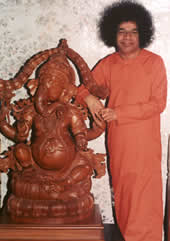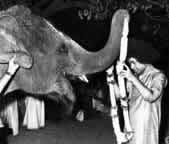|
Home

"Meaning behind the
symbol of Lord Ganesha"
When
you look at a picture of Lord Ghanapathy, what do you see? You may see a
charming, slightly comical elephant-headed God that you have been told to
pray to first, before you start anything new. You may know that he is the
remover of obstacles, and you may even know many of the puranic stories
associated with him. But look closer and you will find a deeper meaning
behind the symbols that are in front of you.
The rat, his vahana or vehicle, represents the lowest form of animal; His
elephant-head represents the highest form of animal; having also the body
of a man shows that he is Ganesha, the Lord of all beings. His large ears
and head indicate that he has gained wisdom through listening and
reflecting on the eternal truths of the vedas. His head and trunk are
curved into the shape of the Om, our most sacred of symbols, representing
the primeval sound of creation and our most powerful mantra in prayer and
meditation. The importance of the elephant is also that it is a herbivore,
eating Sathwic food – a calm and gentle animal that also has immense
strength, which it uses only when needed.

The elephant’s trunk is one of the few instruments in nature that can
perform both gross and subtle actions – it can uproot a huge tree as well
as pick up the tiniest of needles. It signifies the need for us to be able
to develop our intellect, our powers of discrimination, in both the gross
or material world and also in the subtle or spiritual world.
In His right hand he holds a hook or Ankusa and in His left hand he holds
a noose or Paasa. These tools are used back home by elephant-trainers to
tame wild elephants. Symbolically, the mind is like a wild elephant,
running from here to there, in chaos. So we must use the ankusa to tame
and control our mind and then use the noose to tie it down and keep it
close to us– only then can we concentrate, contemplate and meditate.
In another hand He holds a dish of Mothakham. This sweet with it’s hard
outer shell signifies the reward of the sweetness of knowledge that will
give the spiritual seeker joy, satisfaction and contentment as he travels
along the path of enlightenment. It also indicates the importance of
eating the correct Sathwic food in order to progress spiritually.
Lord Ganesha’s large belly is said to contain the whole universe – and is
symbolic of the way we should live our lives. We must be able to accept
and digest whatever experiences we go through – be they good or bad.
Throughout our trials and tribulations we must be equal-minded and realise
that all experiences are learning experiences and will bring us closer to
God.
Lord Ganesha sits with one leg folded up and the other leg resting on the
ground. The leg on the ground tells us that we can live in the world like
anyone else. But the leg pointing upwards tells us that our concentration
and meditation should be ever focussed on the godhead within. Rather like
the lotus that He holds in his hand, which grows in stagnant water, but
raises it’s flowers above the water line so that their purity will not be
blemished by the polluted waters underneath, we can live in this world but
remain unpolluted by the materialism and negative qualities of our
surroundings.
At the feet of our Lord is often spread a huge array of different kinds of
food. The food represents material wealth, power and prosperity and
indicates that if you do live a life of high ideals & principals, these
material benefits will always be available for you, although you will not
be attached to them and they will therefore not hinder your spiritual
progress.
The little rat, or mooshikham, represents desire. Rats, by nature, are
very greedy creatures who will run here and there nibbling and hoarding
far more than they need. If a man has desires, he can waste his whole life
running here and there, fulfilling one desire, only to replace it with
another. Instead, we should be like Lord Ganesha and keep our desires
firmly under control, never allowing them to overwhelm us. According to
the Vinayaka Puranam, the rat also represents the demon Gajamoohaasura who
was destroyed by Lord Ghanapathy. The Lord actually used his tusk to kill
the evil entity, the same tusk that He later used to write down our
holiest of books the Mahabaratha. Interestingly enough, according to the
Puranic stories, all the vehicles of the different Gods and Goddesses
represent the particular asuras (demons) that they defeated. Symbolically
they represent the ignorance of man, which can be kept under control only
by God, in the form of knowledge.
There are 32 forms of Lord Ghanapathy and each has a wealth of Puranic
stories attached to it. They include: Balaganapathy, depicting him as a
child. Herambaganapathy with five heads, ten hands, 3 eyes in each face
and riding on a lion. Vyravignesha, showing his fighting form with many
weapons held in his hands. Lakshmiganapathi, with his wife Goddess Lakshmi.
And Nrittaganapati, a wonderful image of him dancing. Each of these forms
has a wealth of symbolism attached to it. Each will take us closer to the
goal that we seek. We just need to delve deeper to reveal the treasures of
spiritual and philosophical knowledge that our ancient forefathers have
left for us to enjoy.
For those who thirst for spiritual fulfilment, and enjoy the intellectual
stimulation of being a “spiritual detective”, the art of symbolism is the
perfect opportunity to learn about Hinduism at it’s best. So dust off your
deerstalker hat and magnifying glass and begin your search!
online
acknowledgment:www.ghanapathytemple.org.uk/symbolism.htm
-
|